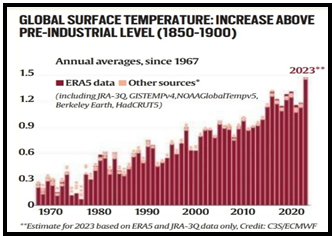WHY 2023 WAS THE WARMEST YEAR?
Why in the News?
- 2023 declared the warmest year since 1850, surpassing the previous record in 2016, according to Copernicus Climate Change Service.
- Temperatures in 2023 likely exceeded any in the last 100,000 years, being 1.48°C warmer than pre-industrial levels.
Source: IE
Drivers of Extreme Warming
- Greenhouse gas concentrations reached unprecedented levels in 2023, trapping more heat in the atmosphere.
- Human activities, especially burning fossil fuels, released substantial greenhouse gases, causing rapid warming.
- The return of El Niño after seven years contributed to the likelihood of breaking temperature records.
| About El Nino
El Nino is a climate phenomenon characterized by abnormal warming of surface waters in the equatorial Pacific Ocean. It disrupts normal weather patterns, leading to various global impacts such as droughts, floods, and changes in temperature and precipitation, affecting agriculture, fisheries, and ecosystems. Greenhouse gases · Greenhouse gases are atmospheric gases that trap heat from the sun, contributing to the greenhouse effect. · They enhance Earth’s natural warming, causing climate change. · Examples include carbon dioxide (CO2) from burning fossil fuels, methane (CH4) from agriculture, and nitrous oxide (N2O) from industrial activities. |

 Source: IE
Source: IE


